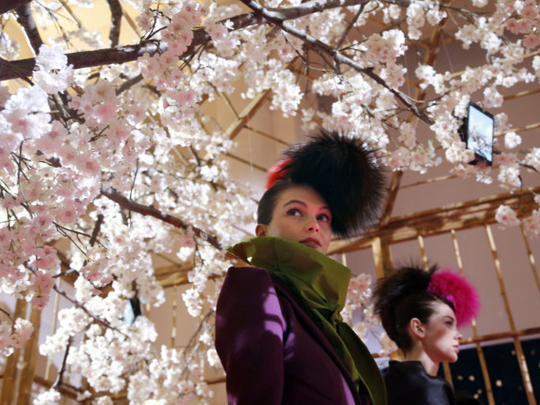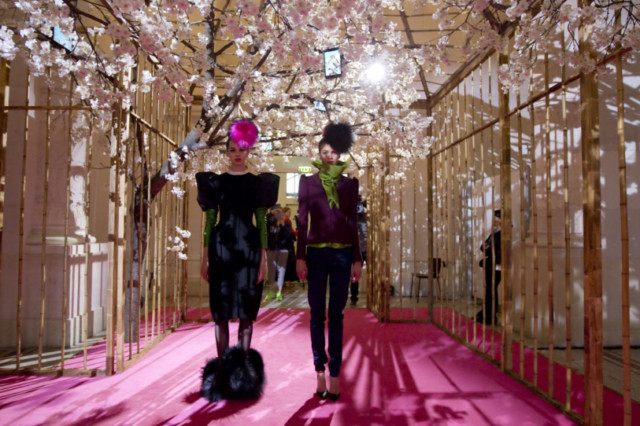
Paris: Christian Lacroix on Monday celebrated the Italian designer Elsa Schiaparelli in his Paris fashion comeback, with voluminous skirts, capes so heavily embroidered they needed three people to lift onto the mannequin, fur trimmed shoes and plumed hats.
In his first collection for the relaunched Schiaparelli house, Lacroix reinterpreted many of the late designer’s influences from fairgrounds and circuses to military uniforms and saris.
Schiaparelli, who died in 1973, was like her great rival Gabrielle “Coco” Chanel one of the fashion world’s most prominent figures between the two world wars.
But her label closed in 1954, a victim of a failure to adapt to post-war austerity.
Partly presented on a rotating carousel of mirrors, Lacroix’s 18-piece “Homage to Elsa” collection also featured many Schiaparelli details such as vast pockets, exaggerated proportions and tiny waists.
“Without Elsa, I would never have become a couturier,” Lacroix told reporters at Paris’s Decorative Arts Museum overlooking the city’s Tuileries garden, adding that the invitation to design for the house had been a “gift”.
The collection’s palette included favoured Schiaparelli shades of aubergine, black, fuchsia and red, the latter two also being favourites of Lacroix.
In one circus inspired piece, a pleated symmetric bustier and oversized skirt was teamed with an embroidered clown’s hat.
The dress required 40 metres (130 feet) of silk and 350 hours’ work.
Describing the collection as a mix of “malice and melancholy”, Lacroix added that he and Schiaparelli were united in a “taste for black, colour and embroidery”.
The Schiaparelli house was officially reopened in July 2012 having been purchased in 2006 by Diego Della Valle, head of the Italian leather goods company Tod’s.
“This season has not been commercialised. That has given me a lot of freedom,” added Lacroix.
“I have always felt very free in couture, it’s perhaps my misfortune,” he said, referring to the loss of his own fashion house in 2009.
Frenchman Lacroix was much feted by fashion editors in the 1990s after he created the first couture house to open in a quarter century in 1987.
Lacroix rode the wave of the 1990s luxury spending boom with a string of exuberant, over-the-top creations that dazzled the fashion world.
But he lost his fashion house in December 2009 when a Paris bankruptcy court approved a plan to end production of the classic label’s haute couture and ready-to-wear lines.
The house had run up losses of 10 million euros (about 15 million dollars) in 2008 after being hit by the sharp downturn of the luxury market.
Lacroix dismissed any idea that his return to fashion might be permanent saying he would instead be continuing with his work on theatrical costumes.
Asked if he thought he might return, he said: “No. What has always excited me about fashion is theatre costumes. My childhood dream - I am achieving it now.”
His comeback collection, considered the highlight of the season, comes at the start of four days of haute couture fashion for autumn 2012/winter 2014.
Haute couture exists only in Paris, where it is a legally protected appellation subject to strict criteria such as the amount of work carried out by hand, the limited number of pieces and the size of a house’s workforce.













